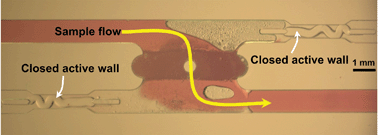Hydrogel-based reconfigurable components for microfluidic devices†
Abstract
In situ liquid-phase photopolymerization (LP3) has been applied to the field of microfluidics to create components within integrated systems. As an extension of LP3 technology, we present reconfigurable components that utilize the swelling of hydrogels. These components can be conveniently used to enhance microfluidic functions and applications. In order to utilize the swelling characteristic of hydrogels to the fullest, we demonstrate strategies to increase the swelling performance temporally and spatially. To this end, two successful applications using the reconfigurable components were tested: (1) active walls to block or divert flow at different steps in the fabrication or assay process, and (2) delivery pistons to move objects to specific locations within the microchannels after device fabrication.


 Please wait while we load your content...
Please wait while we load your content...